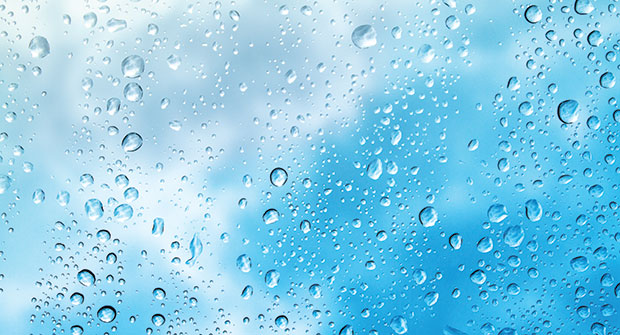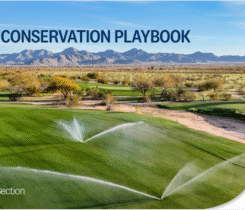Breaking down the research on cool-season turfgrass water use and needs
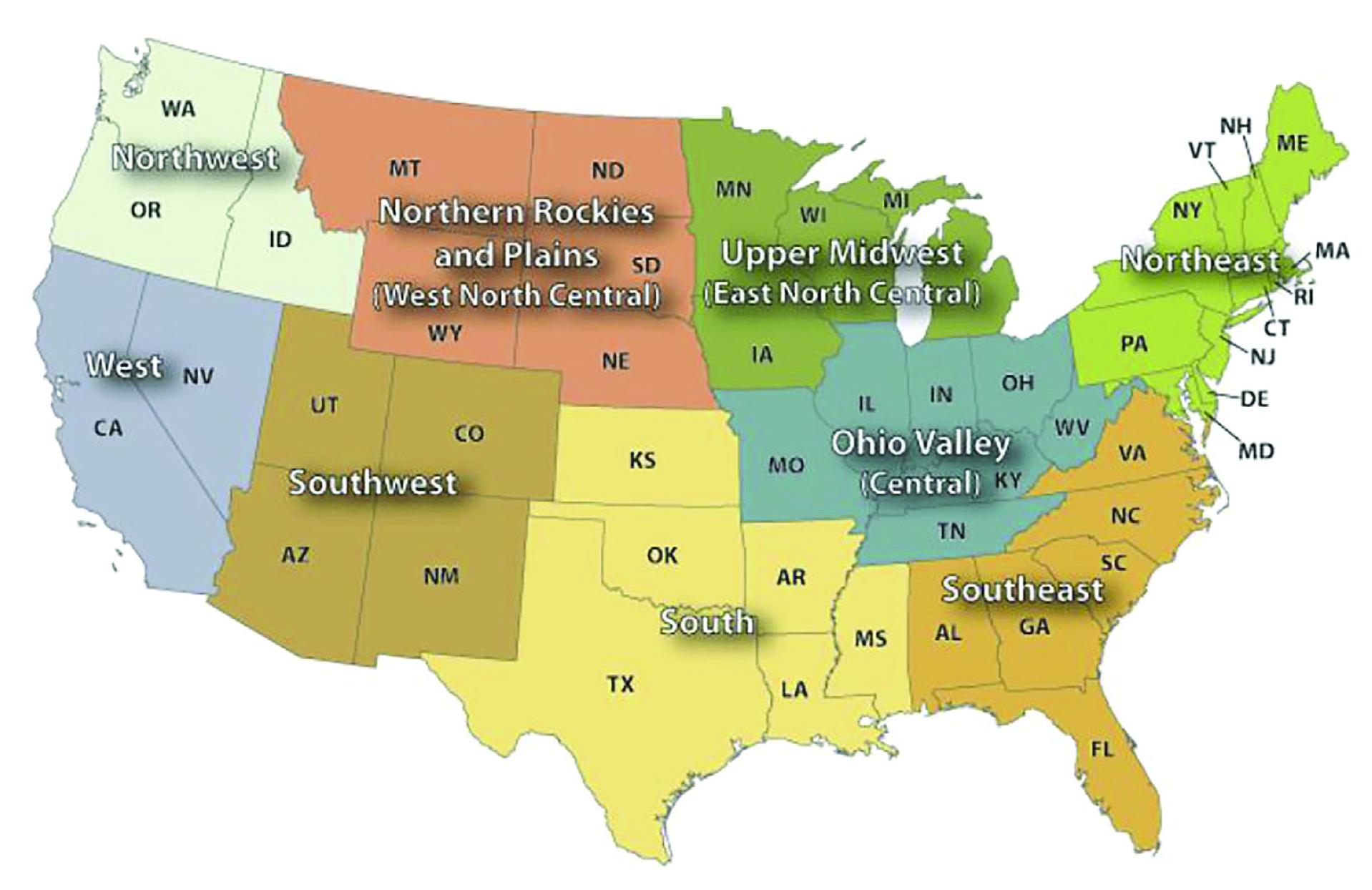
(Fig. 1) Nine climatic regions of the contiguous United States (Karl and Koss, 1984). Map retrieved from the NOAA.
Knowledge of drought resistance for cool-season turfgrasses is necessary because drought stress can occur wherever they grow, even in humid regions with wet climates. We provide a short review of water use and requirements of Agrostis species compared to other cool-season turfgrasses. This article is a small part of a much larger two-part companion review of cool-season turfgrass water use and needs.
The history of early water conservation and quantification methods in turfgrass began in the mid-1930s. We summarize research results since 1980 on cool-season turfgrass evapotranspiration (ET) and deficit irrigation and provide an outlook to identify knowledge gaps and future research needs.
Several authors reviewed turfgrass water conservation, quality, use, requirements, ET measurement techniques and irrigation technology (21, 22, 24 and 28). More recently, researchers reviewed warm-season grasses (C4) for ET, deficit irrigation and drought resistance (10).
Following the advent of ET calculations and an improved understanding of cool-season turfgrass ET, the development of a deficit irrigation strategy became the next key area of water conservation research. In simple terms, a water deficit occurs when plant transpiration exceeds absorption (26).
Building on the use of ET, turfgrass scientists explored deficit irrigation in the 1980s to conserve water without compromising turf quality and the ecosystem services that the turf provides (15). Deficit irrigation provides the turf with water amounts less than evapotranspiration (17).
The improved understanding of plant water loss from climatic factors and the development of water conservation strategies provided the building blocks for modern research focused on new genetics, technology, strategies and management techniques for improved cool-season turfgrass irrigation efficiency.

Table 1
Evapotranspiration
Daily evapotranspiration (ETc) by turfgrass is typically measured using weighing lysimeters under nonlimiting soil moisture. Turf ETc can then be used to derive crop coefficients (Kc) by dividing the plant’s ET (ETc) by reference evapotranspiration (ETo) derived from aerodynamic models (i.e., Penman-based equations) using climatic data (relative humidity, air temperature, wind speed, solar radiation) collected from nearby weather stations. Computed Kc values developed under well-watered conditions can then adjust reference ETo predictions to match the turf’s ETc.
As such, Kc values need to be adjusted (calibrated) to local conditions because Kc values may not extend to other climatic regions or sites. Moreover, different reference ETo equations are also known to vary in their estimate of ETo and are known to deviate from lysimeter-measured ETc even when evaluated under similar climatic environments (6, 18, 30, 37, 38).
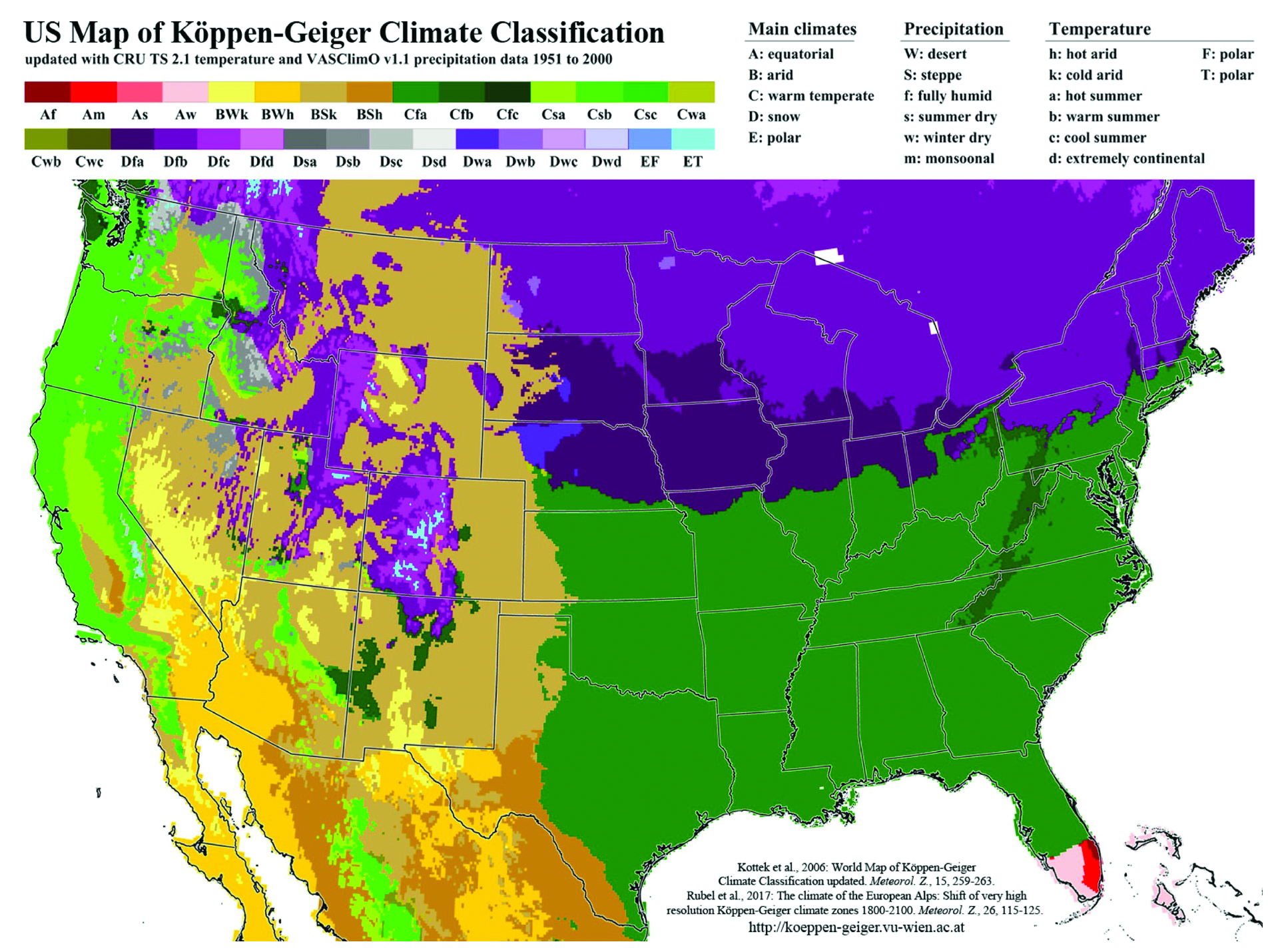
(Fig. 2) Köppen-Geiger climate classification map of the United States (Kottek et al., 2006; Rubel et al., 2017). Map retrieved from http://koeppen-geiger.vu-wien.ac.at/.
Furthermore, reliable ET estimates using appropriate Kc values calculated as ETo × Kc are then used to adjust (replace) only a portion or fraction of the calculated ET of the turf using deficit irrigation replacement levels to promote additional water-saving measures without compromising turf quality and function (summarized in Table 2).
We used several peer-reviewed studies to summarize the turf ETc or Kc of cool-season turfgrass species, where ET was measured principally using weighing lysimeters under well-watered conditions. The height of cut (HOC) varied from 0.3 to 10.5 cm (0.180 to 4.0 inches, e.g., golf course putting green and golf course fairway turf to lawn turf). It included seven of the nine climatic regions of the contiguous United States (20) and two international sites (Germany and Norway) where cool-season turfgrasses are grown (Figure 1).
Accompanying the classified climatic regions of the United States (Figure 1) are the Köppen-Geiger climate classification types and descriptions (Figure 2) (25, 33). The majority of the reported research on turf ET arose from field studies. In contrast, three studies were conducted in growth chambers (19) and another five experiments in greenhouse conditions (5, 27).
All studies measured ETc of mature turf, with only one of the 29 studies reporting turf ETc and Kc values using lysimeters measured during the establishment stages of turf (31). Researchers conducted field studies to measure turf ETc and Kc values during the principal periods of irrigation ranging from one to several months over two or more years or seasons.
Bentgrass vs. other cool-season turfgrasses
Researchers evaluated of ETc and Kc of bentgrass species (Agrostis L. spp.), including creeping bentgrass (Agrostis stolonifera L.), colonial bentgrass (Agrostis capillaris L.) and velvet bentgrass (Agrostis canina L.) in eight studies (Table 1) across four of the nine climatic regions of the United States (Figure 1: East North Central, Northeast, West North Central, Southwest;) and an international site (Norway).
The overall ETc average Agrostis species of 6.12 mm d−1 is 4 to 13 percent higher than Poa spp. (including Kentucky bluegrass), fine fescue (Festuca L. spp.) and perennial ryegrass (Lolium perenne L.) species averages of 5.35 to 5.90 mm d−1 (0.21 to 0.23 inches per day, Table 1).
Except for one study (19), in which researchers did not factor into the weighted average, most studies maintained Agrostis species to approximately 1.0 cm height of cut (0.394-inch HOC) and lower with an average HOC of 0.7 cm (≈ 0.276 inches HOC), typical of golf course putting green and fairway turf. For six of the seven published studies on Agrostis water use, Agrostis evaluations were for a single cultivar of creeping bentgrass (L-93, Memorial, Penncross or Providence), colonial bentgrass (Cezanne or Tiger 2) and velvet bentgrass (Greenwich or Legendary).
In one of the seven field experiments with 10 cultivars of creeping bentgrass, researchers observed a greater than threefold differential in ETc (3.2 to 10.7 mm d−1) in the growing season, with a significant range observed in Kc of 0.73 to 1.11 (34). Researchers observed considerable variation (19 percent) in field studies for this species (Table 1).
There have been very few to no experiments published on ETc and Kc of bentgrass species in the East North Central, Central and West North Central climatic regions of the United States, where this species is common on golf courses.
Additional research is needed to evaluate ETc and Kc of Agrostis species to include greater numbers of cultivars in testing conducted at almost all of the climatic regions of the United States where Agrostis species are adapted.

Table 2
Measurements
There are different reference ETo models to calculate Kc, including modified Penman (13) and FAO 56 PM (2). In the 1980s, researchers compared Pan E with the modified Penman ETo in calculating Kc (3,9).
Under the same climatic conditions in the cool-humid Northeast region (New England), the Aronson et al. study of three major cool-season turfgrass species reported 11 percent higher Kc using Pan E than the modified Penman ETo (3). Pan E produces a disproportionately lower reference ETo than the modified Penman reference ETo when calculating Kc values.
In the warm-humid Southeast region, Kc values for tall fescue between Pan E and modified Penman reference ETo were similar. In the arid Southwest, the modified Penman reference ETo generated 10 to 25 percent higher ETo than FAO 56 PM ETo (7, 8).
Based on these results, researchers recommend using the FAO 56 PM in future water use studies to reduce confusion in developing appropriate Kc for turf use. Additional research in Kansas demonstrated the original Penman reference ETo (29) overestimated cumulative lysimeter ET by as much as 38 percent compared with only 1.5 percent when using FAO 56 PM reference ETo (6).
Crop coefficients vary with time (seasons) to accommodate the growing turf and mowing height, ground cover and growth stage. However, studies from the cool-humid regions of the Northeast and East North Central United States recommend one Kc (0.80 to 1.0) for all irrigation months (3, 32, 35).
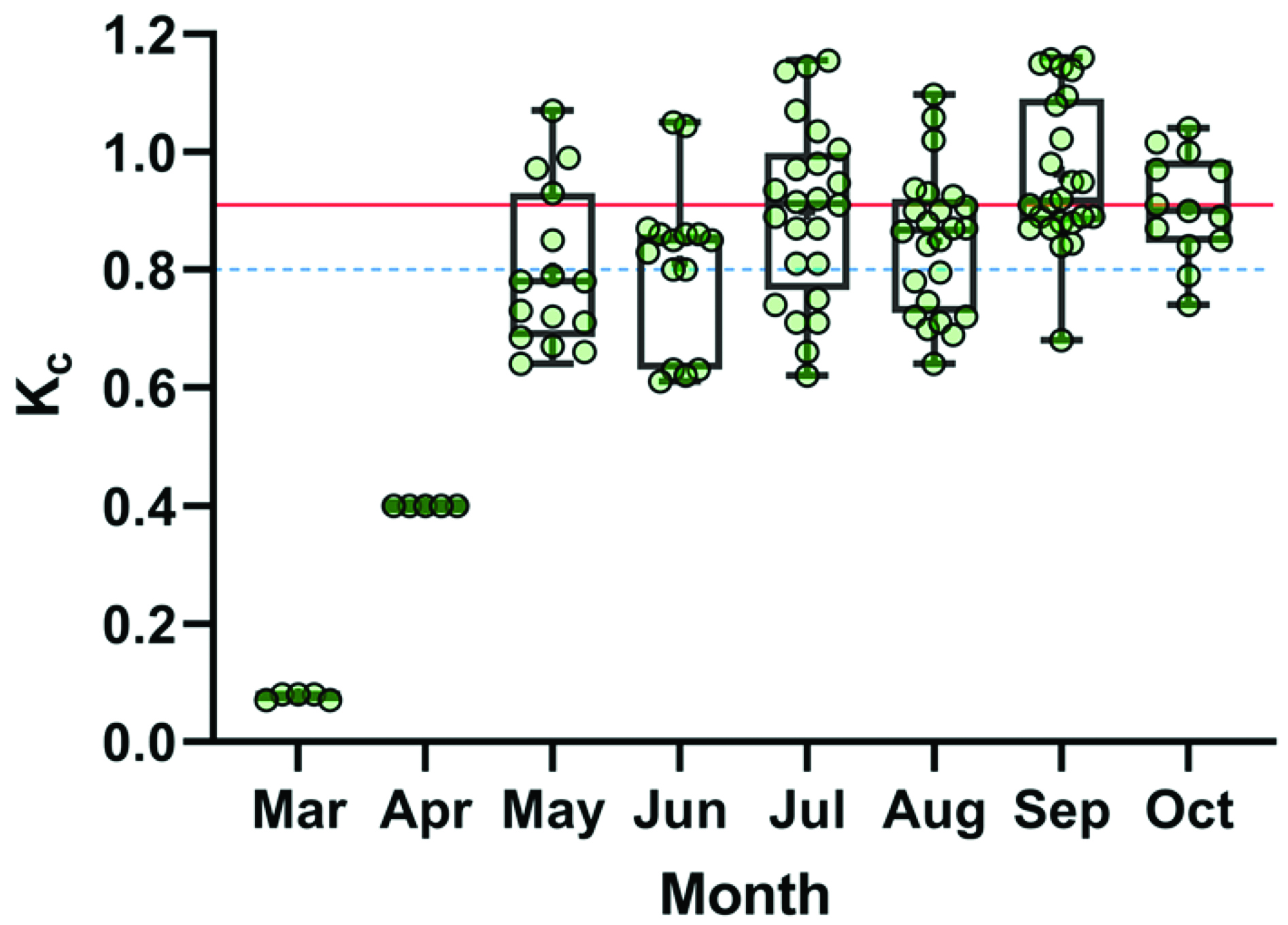
(Figure 3) A box and whisker plot with jittered data points, maximum, minimum, median and mean (+) monthly crop coefficients (Kc) across all cool-season turfgrass species from field experiment data from Table 1. The boxes represent the data between the lower and upper quartiles. The red line indicates the mean Kc (0.91) weighted average across the growing season months of May through October. The blue dashed line at 0.8 represents the general Kc recommendation for cool-season turfgrass species during a growing season.
Published research on Kc averaged by species ranged from 0.85 (fine fescues) to Kc averages approaching 1.0 [Agrostis species (0.94) and tall fescue (0.95)] with Lolium and Poa species having intermediate Kc values of 0.91 to 0.92 (Table 1).
Figure 3 summarizes the 29 field experiments for Kc. The blue line represents the past general recommendation of a Kc of approximately 0.80 for cool-season turfgrass species. The compiled data from the field experiments illustrate slight variation from month to month, but the overall mean Kc from May to October is 0.877, which aligns with past recommendations (Figure 3).
Regardless, additional research with each cool-season turfgrass species in more climatic regions of the United States would provide more accurate Kc estimations that could improve irrigation efficiency. Crop coefficients with values less than 1.0 suggest less water is needed than predicted by the reference ETo to match measured ETc using lysimeters.
Some studies report Kc values greater than 1.0 and as high as 1.42 when using Pan E or the modified Penman ETo ( 3, 23, 34, 36), suggesting the reference ETo underestimated measured ETc. Most calculated Kc values derived using FAO 56 PM ETo are consistently less than 1.0, underscoring the problems when comparing studies using different reference ETo equations.
There is a need for more research on ET and Kc during the establishment of grass cover to distinguish establishment from mature turf. This is because of the potential for distinctly lower transpiration and water requirements from the lower fraction of ground covered by vegetation during establishment.
Conclusions
Over the last 35 years, researchers have measured ETc for Agrostis spp., fine fescue, tall fescue, Lolium spp. and Poa spp. and reported weighted averages of 6.12, 5.52, 7.79, 5.90 and 5.35 mm d−1, respectively, with an overall weighted average ETc rate of 6.25 mm d−1 across these cool-season turfgrass species based on 22 peer-reviewed studies (Table 1).
In addition to different equations and procedures that offer varying estimates of reference ETo, it is essential to recognize that reference ETo is a function of weather and climatic (evaporative) factors, assuming a well-watered turf and estimates of plant height and surface roughness.
Estimating Kc values is mainly a function of crop (plant) characteristics in the transfer of reference ETo to approximate turf ETc for turfgrass use. Many turfgrass plant characteristics are related to culture and maintenance practices. The relationships between these plant characteristics and turfgrass evapotranspiration were determined under nonlimiting soil moisture using weighing lysimeters.
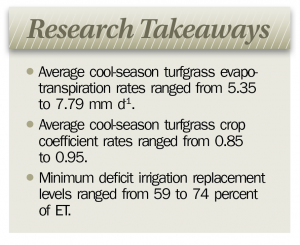 Average crop coefficients ranged from 0.85 to 0.95, with a weighted average of 0.91 across species and vary slightly from month to month based on ten peer-reviewed studies. These findings align with past irrigation practice recommendations of a Kc of 0.8 for cool-season turfgrass species during a growing season.
Average crop coefficients ranged from 0.85 to 0.95, with a weighted average of 0.91 across species and vary slightly from month to month based on ten peer-reviewed studies. These findings align with past irrigation practice recommendations of a Kc of 0.8 for cool-season turfgrass species during a growing season.
We need further research to standardize the estimates of Kc values in turfgrass studies, such as using a standard ETo (e.g., ASCE or FAO-56) across studies and developing a standard measurement protocol to improve consistency across future studies.
We also need more research on turfgrass species, such as Agrostis, Lolium and fine fescue taxa. Moreover, we need experiments for ET and Kc for Kentucky bluegrass and tall fescue in the Central, East North Central, West North Central and Northeast regions.
Deficit irrigation is an important water conservation strategy studied in one or more cool-season turfgrass species in 17 studies. Minimum deficit irrigation replacement levels for acceptable turf quality have ranged from 59 to 74 percent of ET with different irrigation intervals in various seasons. Typically investigations took place during the summer months.
Additional research on deficit irrigation replacement levels in cool-season turfgrass species, especially fine fescue and perennial ryegrass, is required and investigations on the impact of deficit irrigation on rooting characteristics over time are warranted.
Of the 24 lysimeter studies measuring ET and Kc, researchers conducted only seven in northern climatic regions (East North Central, West North Central and Northeast) but none in the Northwest or Central climatic regions. Only three of 17 studies evaluating deficit irrigation replacement levels took place in northern climatic regions (East North Central, Northeast and Northwest).
There is a need for further research on ET, Kc and deficit irrigation in northern and central climatic regions of the United States to develop further and improve our understanding of plant water loss related to climatic factors, development of water conservation strategies and management techniques for enhanced cool-season turfgrass irrigation efficiency.









